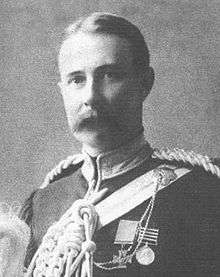Hampden Zane Churchill Cockburn
Major Hampden Zane Churchill Cockburn VC (19 November 1867 – 12 July 1913) was a Canadian soldier, and recipient of the Victoria Cross, the most prestigious award for gallantry in the face of the enemy that can be awarded to British and Commonwealth forces.
Major Hampden Zane Churchill Cockburn VC | |
|---|---|
 | |
| Born | 19 November 1867 Toronto, Ontario, Canada |
| Died | 12 July 1913 (aged 45) Maple Creek, Saskatchewan, Canada |
| Buried | |
| Allegiance | |
| Service/ | Canadian Militia |
| Years of service | 1897–1913 |
| Rank | Major |
| Unit | The Royal Canadian Dragoons |
| Battles/wars | Second Boer War |
| Awards | Victoria Cross |
Second Boer War
Born in Toronto, Ontario, Canada, Cockburn was a graduate of Upper Canada College in Toronto.
When the Second Boer War broke out in 1899, Cockburn was a 32-year-old lieutenant in The Royal Canadian Dragoons, Canadian Militia, and was posted to South Africa with his regiment, where the action took place for which he was awarded the VC.
On 7 November 1900, during the Battle of Leliefontein near the Komati River, a large force of Boer commandos sought to encircle a retreating British column whose rearguard comprised two troops of Royal Canadian Dragoons and two 12-pounder guns of "D" Battery, Royal Canadian Field Artillery.[1] Cockburn and Lieutenant Richard Turner commanded a small group of troopers who repulsed the Boers at close range, allowing the two field guns to escape capture. Sergeant Edward Holland of the Royal Canadian Dragoons, ably assisted them with good machine-gun work, finally fleeing in the face of superior Boer force with the machine gun under his arm to avoid its capture.[2] All the men under Cockburn's command were either killed, wounded or captured. Cockburn was also wounded during the action.
Following the battle, three men of the Royal Canadian Dragoons were awarded the Victoria Cross: Cockburn, Turner and Holland.
The citations were published in the London Gazette of 23 April 1901. Cockburn's read:
Lieutenant Cockburn, with a handful of men, at a most critical moment held off the Boers to allow the guns to get away; to do so he had to sacrifice himself and his party, all of whom were killed, wounded, or taken prisoners, he himself being slightly wounded.[3]
Return to Canada
Following the Boer War, Cockburn returned to Canada, and eventually achieved the rank of major. He died in a horse-riding accident in Grayburn, Saskatchewan,[1] in 1913, and was buried at St. James Cemetery, Toronto, Ontario, with a headstone at Hill A. Section S 1/2. Lot 11.
Medal
Cockburn's Victoria Cross and sword were, for many years, displayed in the lobby of his alma mater, Upper Canada College. In 1977, the school had a high-quality copy made for display, and moved the original to safe-keeping.
References
- "Victoria Cross - The South African (Boer) War 1899-1902: Hampden Zane Churchill Cockburn". National defence and the Canadian Forces. Department of National Defence. Retrieved 2015-11-18.
- "Canada & The South African War, 1899-1902: Canadian Victoria Cross Recipients". Canadian War Museum. Retrieved 2015-11-18.
- "No. 27307". The London Gazette. 23 April 1901. p. 2775.
- Monuments to Courage (David Harvey, 1999)
- The Register of the Victoria Cross (This England, 1997)
- Victoria Crosses of the Anglo-Boer War (Ian Uys, 20